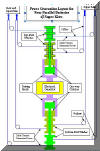|
Using superkites and winches to generate
electric power |
||
|
There are many ways by which kites may generate electric power from
high-altitude winds. They may carry generation equipment at high altitude
and transmit power to the ground via insulated cables. The kite technology
may also generate cyclic tensile forces on the cable and transmit those
forces to ground level to generate electrical power. It may also be
possible to coordinate multiple parallel groups of such kites to generate
electrical power in a single installation. Two cable winches may be mounted on the same driveshaft and operate
back-to-back. The driveshaft would drive electrical generation equipment
and as one winch reels out, the other winch would reel in. The cables of
each winch would lead outward at an angle of 180 degrees to pulleys
located 50 meters to 100 meters apart. Each cable would loop around the
pulley to a sled on rails. The system of winches, cables, pulleys and
two sleds on rails may all be mounted on a single structure placed on a
circular rail. It would be possible to employ two parallel batteries of superkites and two pairs of winch-driveshafts to drive one pair of counter-rotating alternators. One driveshaft would be hollow and contain a smaller concentric driveshaft that would be driven from the companion winch-driveshaft and drive the alternators through a second set of one-way clutches. The two sets of parallel superkites would operate 90 degrees out phase with each other. When one set of kites on one cable system reaches the end of the travel cycle, the other set of kites on the companion cable system would be in the middle of the travel cycle and would keep the electrical alternators continually rotating and producing electrical output. The rail-mounted sleds of each set of kites could be staggered at intervals of 50 meters to 100 meters. It is possible to use two parallel sets of superkites to
pull on two bidirectional winch sets that are mounted in-line
(collinearly). The winch sets will drive through two sets of one-way
clutches to rotate a single alternator in one direction. The cables on one
winch set would pull from the top side while the cables on the
complementary winch set would pull from the bottom side. An observer
standing upwind of the installation would see the right-hand kites
pulling cables that drive the winch sets. The main tension load on one of
the cables may pull on the top side of a winch and drive through a one-way
clutch to drive the alternator in the clockwise direction.
Several researchers have theorized on the optimal flight path of kites
used to generate electrical power at ground level. The discussion revolves
around oval flight paths in both the longitudinal and transverse direction
as well the figure-8 flight path in these directions. A battery of
superkites with multiple control lines attached to a single sled could fly
either an oval path or a figure-8 path in either the longitudinal or
transverse direction. The flight paths of several parallel batteries of
such kites would have to be restricted to the longitudinal or fore-and-aft
directions and may likely be an oval flight path |
 |
|
| February 6, 2009 Discuss: Notes@EnergyKiteSystems.net | ||

